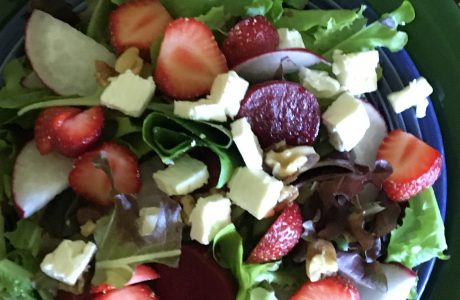The MIND Diet Basics
The MIND Diet was developed and introduced by Nutritional Epidemiologist Martha Clare Morris PhD and her colleagues at Rush University Medical Center in Chicago Illinois. The MIND Diet basics are a common sense set of guidelines that still allows a little flexibility when making healthy food choices.
It’s a whole food based diet that focuses on incorporating 10 healthy food types while limiting 5 unhealthy choices.
Ten Healthy Choices for a Healthy Brain:
- Dark leafy greens
- Other vegetables
- Nuts
- Berries
- Beans, lentils, soybeans
- Whole grains
- Seafood
- Poultry
- Olive oil
- Wine in moderation
Five Foods to Limit:
- Red meat
- Butter and margarine
- Cheese
- Pastries and sweets
- Fried or fast food
So how does this work? There are no macros or calories to count, although everyone knows that eating more calories than you burn will ultimately result in weight gain, common sense needs to prevail here.
There really is no food that is completely off limits. The idea, however, is to eat healthy on a daily basis so that when you do go out to restaurants, or celebrations that typically include a less than healthy menu, a little indulgence won’t completely sabotage your efforts.
The MIND Diet in Action
Under ideal circumstances, these are the choices we should work toward on a weekly basis:
- Berries ~ One serving at least twice a week.
- Whole grains ~ At least 3 servings per day.
- Nuts ~ At least one 1 oz serving at least 5 days per week.
- Beans and/or legumes ~ 1 serving at least every other day.
- Poultry ~ Twice a week.
- Seafood ~ At least once a week
- Red wine ~ 5 ounces per day. If you don’t already drink alcohol, don’t start.
- Healthy fats ~ Extra Virgin olive oil is encouraged. Limit butter to no more than 1 tablespoon per day if at all.
- Cheese and fried foods ~ Limit to one serving per week.
- Red meat, pastries and sweets ~ No more that 5 times per week if at all.
- Dark leafy greens ~ At least one serving per day plus one other vegetable at minimum.
Berries
Berries are encouraged for brain health. Blueberries and strawberries are especially linked to decreasing cognitive decline in older adults. They contain antioxidant properties to fight against cancer as well as Alzheimer’s Disease clearing our bodies of free radials that accumulate through not only self inflicted stress, but stress caused by life in general that we have no control over.
Vegetables to Focus On
Vegetables, especially those with the most vibrant colors, offer additional antioxidants to decrease the rate of cognitive decline. Dark leafy greens would be things like spinach, kale, microgreens, swiss chard or beet greens, collards, arugula etc. The darker the leaf the more nutrient rich it is. I would also argue that the younger the leaf, as in microgreens or baby leaf greens, the more nutrient dense it is.
Studies have also shown that the biggest protective benefit from vegetables is to consume at least 2 servings a day. If you are a veggie lover and eat more than that in a day . . . great! But the biggest benefit was noted at 2 servings per day. More than that is beneficial, but at a lower percentage. So shoot for at least 2 servings, one being leafy greens.
The Importance of Vitamin E
One serving of nuts will be your biggest booster of vitamin E which is considered the fire extinguisher for what sparks the free radical effect in the brain causing a lack of communication between brain cells.
That said, it’s easy to chow down on an entire pound bag of mixed nuts in one sitting which will sabotage your cholesterol and sodium efforts. One ounce is, on average, the number of nuts you can spread out in the palm of your hand an not overflow onto your fingers. Sprinkle them on your salad or in a sautéed vegetable dish.
There are 8 forms of Vitamin E and all of them are found in nuts and seeds, as well as in spinach and mangos. This is where supplements are not always what they are cracked up to be. A Vitamin E supplement may only contain 1 type of vitamin E. If you get too much of 1 type, the body cannot absorb any other forms of E. This is why it’s so important to get our nutrients from our food when possible.
Whole Grains
Whole grains have the benefit of B vitamins and Vitamin E offering, in addition to brain health, protection against cardiovascular disease and diabetes.
Complex carbohydrates in the form of whole grains, nuts, and seeds are broken down more slowly and therefore offer a more consistent supply of necessary glucose to the brain.
White flour, breads, candy, sweets, etc. will give us the sugar “high” that give you that immediate rush of energy only to leave you in a state of mental and physical exhaustion a short time later.
Alzheimer’s Disease has also been deemed by some as “diabetes of the brain” indicating that high glucose concentrations in the brain from simple carbohydrates play a part in the development of Alzheimer’s disease. Including whole grains in our diet can help in the regulation of glucose levels in the brain.
Vitamin B12
Vitamin B12 also plays a role in brain health slowing cognitive decline. B12 typically declines with age. Foods that can offer B12 in this diet would be things like chicken, tuna, and salmon. However if, after talking with your doctor, it is determined more B12 is needed, here is a situation where a supplement may be beneficial.
Beans and Legumes
Beans and legumes are a great source of protein. They do contain vitamin B components but not B12. They are extremely beneficial in keeping blood sugar and cholesterol regulated as well as having a positive affect on gut health due to their high fiber content.
Peanuts are considered a legume. Along with the legume benefits they offer Vitamin E protection as well.
Healthy Fats
Saturated fat and trans fats are both well known to be linked to the increased risk of Alzheimer’s Disease. Our brain needs fat to function. But unsaturated healthy fat are the focus fats of the MIND diet.
Olive oil is the biggest recommended oil for cooking. Extra virgin olive oil is also a source for that all important vitamin E.
There are conflicting ideas about cooking with olive oil questioning whether or not the health benefits are retained during the cooking process especially at higher temperatures.
While some of the vitamin E may be destroyed at higher temperatures, olive oil is very resistant to heat and does not oxidize or go rancid in the cooking process. It maintains its monounsaturated benefits making it the healthiest choice for cooking.
Avocados, olives, avocado oil, nuts and seeds are also healthy fats with monounsaturated fat properties.
Is Alzheimer’s Disease Hereditary?
The MIND diet, without getting too technical into the physiology of the brain, extinguishes the harmful beta amyloid proteins that stop brain cells from being able to communicate with one another.
There is a gene that can be passed between the generations called the ApoE4 that can be linked to the development of Alzheimer’s. But the good news is that studies have shown that by following the MIND diet to a “T” you can decrease the risk of developing the disease by 53%. And those who follow the diet moderately well have shown a decline in risk by 35% even if you test positive for the ApoE4 gene!
This is huge in the whole scheme of things! Especially if you know you are at risk. If you have watched people suffer with this disease, why would you not want to decrease your risk?
Also proof that genes do not have to equal your destiny!
Exercise is another component to this. Adding a 40 minute walk 3 times per week only increases your odds for a healthy brain with the added benefit of improving your overall cardiovascular health and keeping your blood pressure at a normal level. If you are new to exercise, it is always the best practice to get clearance from your doctor before starting any strenuous program.
The MIND diet is proving to be beneficial beyond the brain and cardiovascular health. It has been shown to improve A1c levels in diabetics, lower blood cholesterol levels, and decrease the risk of some cancers.
As with anything, compliance is huge. I have been taking care of patients in hospitals for 34 years, and compliance is the biggest problem I see.
I get it. I love cheese and steak as much as the next omnivore. I also love sweets. Just know that you don’t have to completely eliminate these things in following this diet. Keeping things in the proper perspective will go a long way in decreasing the risk of brain decline.
I have no intention of eliminating Grandma’s cookie recipe from my world. But I can be more cognizant of how often I indulge.
In Conclusion
I encourage everyone to do your research! There is so much more I could elaborate on but, at the risk of overwhelm, have decided to keep this post simple.
I believe that the best way to combat this disease is through our lifestyle. I grow the majority of the vegetables I eat. You can too! You would be surprised at the amount of food you can grow in a small space. And without the fear of where it has been and how far it has traveled.
If you can’t grow for yourself, I encourage you to buy from local growers. Knowing where your food comes from is so important!
The list of people below are a great way to start researching but there is so much more available if you want to keep going!
Click here for the Pan Seared Scallops With Fresh Lettuce Greens recipe!
If you missed my first post on my “why” when researching the MIND Diet and the affect it has on our brain, click here!
People referenced for this article:
- Martha Clare Morris Nutritional Epidemiologist at Rush University Medical Center in Chicago Illinois
- Neal Barnard, MD, FACC, is an Adjunct Associate Professor of Medicine at the George Washington University School of Medicine in Washington, D.C., and President of the Physicians Committee for Responsible Medicine.
- Elizabeth Newton RD Secretary of the Blue Ridge Academy of Nutrition and Dietetics
- Keith Pearson PhD, RD Assistant Professor at Samford University; Healthline.com
- Camille Noe Pagan freelance writer for WebMD; health.com, prevention.com
© 2020, Pamela. All rights reserved.





